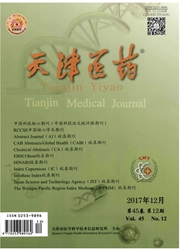

 中文摘要:
中文摘要:
目的探讨血清铁代谢指标与病毒性肝炎肝脏炎症活动的关系,以及乙型与丙型肝炎患者血清铁代谢指标的差异。方法人组135例乙肝患者和31例丙型肝炎患者,收集患者血清铁(SI)、血清铁蛋白(sF)、转铁蛋白(TRF)、总铁结合力(TIBC)等指标,并计算转铁蛋白饱和度(Ts),肝功能指标丙氨酸转氨酶(ALT)、天冬氨酸转氨酶(AST)、总胆红素(TBIL)、白蛋白(ALB)。从乙肝患者中选取与丙肝患者在年龄、性别比例、肝功能水平相匹配的39例患者,比较2组铁代谢指标水平。结果TRF、TIBC与年龄呈负相关;SI、sF、TS分别与ALT、AST、TBIL呈正相关,SF、TS与ALB呈负相关;TRF、TIBC分别与ALT、AST、TBIL呈负相关,与ALB呈正相关(r=0.551)。丙型肝炎患者的sF高于乙型肝炎患者,TRF及TIBC低于乙型肝炎患者(均P〈0.05),sI及Ts在2组中差异无统计学意义。结论血清铁代谢指标与肝脏炎症活动有显著相关性;慢性丙型肝炎与慢性乙型肝炎患者相比,铁超载现象明显。
 英文摘要:
英文摘要:
Objective To investigate the relationships between parameters of serum iron metabolism and liver in- flammatory activity grades, and to find out the difference in parameters of serum iron metabolism between patients with hepa- titis B and patients with hepatitis C. Methods A total of 166 patients with viral hepatitis were enrolled in this study, in- cluding 135 case of hepatitis B and 31 cases of hepatitis C. The serum iron metabolism indexes including serum iron (SI), se- rum ferritin (SF), transferring (TRF), total iron binding capacity (TIBC) were collected, and the transferring saturation (TS), al- anine aminotransferase (ALT), aspartate aminotransferase (AST), total bilirubin (TBIL) and albumin (ALB) were calculated. Thirty-nine patients were selected from 135 hepatitis B patients by corresponding gender, age and liver function with 31 hep- atitis C patients. The indicators of iron metabolism were compared between two groups. Results There was a positive corre- lation between age , TRF and TIBC. There were positive correlations between SI, SF, TS and ALT, AST, TBIL respectively, and negative correlations between SF, TS and ALB. TRF and TIBC were negatively correlated with ALT, AST and TBIL, but positively correlated with ALB (rx=0.551, P 〈 0.001). The value of SF was significantly higher in patients with hepatitis C than that of patients with hepatitis B. The levels of TRF and TIBC were significantly lower in patients with hepatitis C than those of patients with hepatitis B (P 〈 0.05). There were no significant differences in SI and TS between two groups. Conclu- sion There was a significant correlation between parameters of serum iron metabolism and live inflammatory activity grades. The iron overload phenomenon is much common in patients with chronic hepatitis C than that of patients with chronic hepatitis B.
 同期刊论文项目
同期刊论文项目
 同项目期刊论文
同项目期刊论文
 期刊信息
期刊信息
